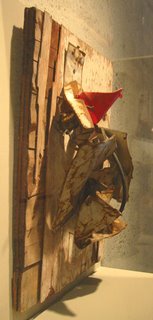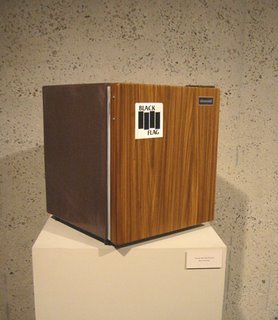
Visitor note: Second Sundays are free under a corporate sponsorship.
Last Sunday I visited the Oakland Museum of California. My particular goal was to see a group of early videos by Bill Viola, recently purchased by the museum along with several later works. As it turned out, the early videos were not on rotation at the time I visited. So I sampled two Viola videos from the 1990s. Mostly, though, I wandered around the permanent exhibits of paintings, sculpture, and photography. I hadn’t done that in a long time.
My visit was a reminder of why art lovers tend to forget the Oakland Museum, and why they shouldn’t. For reasons hard to decipher, this museum has always under-performed as an art destination. The collection includes many fine works, but a significant number remain in storage for lack of display space. The regional focus tends to be embraced in ways that separate the region from broader artistic trends, which diminishes the work and the public's understanding of it. Also, there is insufficient appreciation and collecting zeal for art of the past decade, likely to be seen as a key period. The range and quality of recent Bay Area artwork have been remarkable by any standard.
The Oakland Museum’s curatorial staff must deal not only with tight quarters but with a physical plant that is a dated, even dismal. Lighting is remarkably poor. Many of the interior walls are either rough concrete or sections of dark wood (vertical flooring!)—neither of which is a suitable background for most of the art. On the day of my recent visit, a quantity of display spotlights had burned out, and there were white plastic buckets here and there to catch leaks. The air temperature seemed to hover near 60°.
Behind the scenes, questions also have been raised about how the museum has been storing its holdings off-site. The storage situation became an issue in the museum’s accreditation. The museum has addressed this by purchasing a warehouse in which it collections can be maintained in a modernized environment.
It’s obvious the museum has a money problem. In recent years, other Bay Area art museums have benefited from tens of millions of dollars in donations. Money on this scale has largely bypassed Oakland. However, thanks to a bond measure passed in 2002, nearly $24 million will be spent on Oakland Museum improvements, including about $8 million for renovation of the art galleries. That phase of construction is scheduled for next year.
In the overall renovation, it would be marvelous if the museum could carve out a small gallery where Bay Area artists could be shown in compact, rapidly organized, pulse-taking exhibits. There are so many local artists who do not receive the exposure they deserve.
Despite its woes, the Oakland Museum is well worth a visit. Occasionally there is a special exhibit of extraordinary quality, such as the David Ireland retrospective in 2004. Even when the special exhibits don't strike your fancy, the permanent art collection offers plenty to see. I spent my recent visit mostly in the Postwar to Contemporary galleries, but there is also notable work from earlier periods.
From the 19th Century, the museum has George Henry Burgess's panoramic painting from 1891, about 11 feet wide, that depicts San Francisco in 1849 (image below, adapted from the museum website).
 From the 1920s, there is August Gay’s colorful small painting, “Ranch in Carmel Valley” (photo below). Gay was a member of Oakland’s Society of Six.
From the 1920s, there is August Gay’s colorful small painting, “Ranch in Carmel Valley” (photo below). Gay was a member of Oakland’s Society of Six. From the 1930s, the museum is presenting a small selection of photos from its major Dorothea Lange archive. Maynard Dixon, who was Lange's much-older husband (until 1935), also confronted the social troubles of the day. His painting “Scab” illustrates strife on the San Francisco docks (first image below). A different style from the period is Rinaldo Cuneo’s small “Earth Patterns” (second image below). Admirers of Gottardo Piazzoni will discover a lovely easel-sized work, “The Fog Bank.”
From the 1930s, the museum is presenting a small selection of photos from its major Dorothea Lange archive. Maynard Dixon, who was Lange's much-older husband (until 1935), also confronted the social troubles of the day. His painting “Scab” illustrates strife on the San Francisco docks (first image below). A different style from the period is Rinaldo Cuneo’s small “Earth Patterns” (second image below). Admirers of Gottardo Piazzoni will discover a lovely easel-sized work, “The Fog Bank.”
 From the 1940s there is a small painting by Mark Rothko, which was unlit during my visit (photo below).
From the 1940s there is a small painting by Mark Rothko, which was unlit during my visit (photo below). From the 1950s, there is Bruce Conner’s creepy assemblage, “Spider Lady House” (detail below). Also, Richard Diebenkorn’s “Berkeley No. 20.” (second photo below).
From the 1950s, there is Bruce Conner’s creepy assemblage, “Spider Lady House” (detail below). Also, Richard Diebenkorn’s “Berkeley No. 20.” (second photo below).
 There is good deal of work from the 1960s. One example is a wall piece by George Herms, “Lady MacBeth” (first image below, showing a side angle). Another is Frank Lobdell’s “15 April 1962” (second image below). A third is Nathan Oliveira’s large “Spring Nude” (third image below), a good early example of a style that the artist has overplayed through repetition over the decades. There is also work by Wayne Thiebaud, Ed Ruscha, Larry Bell, John McLaughlin, and others.
There is good deal of work from the 1960s. One example is a wall piece by George Herms, “Lady MacBeth” (first image below, showing a side angle). Another is Frank Lobdell’s “15 April 1962” (second image below). A third is Nathan Oliveira’s large “Spring Nude” (third image below), a good early example of a style that the artist has overplayed through repetition over the decades. There is also work by Wayne Thiebaud, Ed Ruscha, Larry Bell, John McLaughlin, and others.

 From the 1970s, there is “My Shadow” (photo at top of posting), a characteristic work by the African-American artist Robert Colescott. He’s a forerunner of such notables as Kara Walker and Kerry James Marshall. Also on display is Diebenkorn’s “Ocean Park No. 107” (photo below). There are also a couple of Mel Ramos paintings from the period.
From the 1970s, there is “My Shadow” (photo at top of posting), a characteristic work by the African-American artist Robert Colescott. He’s a forerunner of such notables as Kara Walker and Kerry James Marshall. Also on display is Diebenkorn’s “Ocean Park No. 107” (photo below). There are also a couple of Mel Ramos paintings from the period. From the 1980s, there is an atmospheric walk-in installation by Michael McMillen, “Aristotle’s Cage.” From the 1990s, there is “Just a Matter of Time,” a wall installation by Paul Kos in Soviet hammers and sickles hang from 15 cuckoo clocks. There is also a photo by Carrie Mae Weems from her terrific Kitchen Table Series.
From the 1980s, there is an atmospheric walk-in installation by Michael McMillen, “Aristotle’s Cage.” From the 1990s, there is “Just a Matter of Time,” a wall installation by Paul Kos in Soviet hammers and sickles hang from 15 cuckoo clocks. There is also a photo by Carrie Mae Weems from her terrific Kitchen Table Series.The more recent work includes artists such as Maria Porges, Larry Sultan, Enrique Chagoya, Reagan Louie, and Kathryn Spence. I was happily surprised to see something as up to date as Kaz Oshiro’s “Small Fridge #5 (Black Flag),” from 2005. Like Oshiro’s other work in this vein, the sculpture (photo below) is a paint-on-canvas construction, which is open at the back to reveal how it is made.


No comments:
Post a Comment